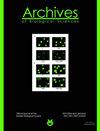组织转谷氨酰胺酶参与活动性慢性胃炎的炎症过程
IF 0.8
4区 生物学
Q4 BIOLOGY
引用次数: 0
摘要
由于组织转谷氨酰胺酶-2 (TG2)可以代表一些胃肠道疾病的炎症标志物,我们的目的是评估TG2和炎症标志物?胃窦粘膜内容物活检揭示慢性胃炎炎症的组织学和生化背景。78例因消化不良症状接受上消化道内镜检查(UGIE)的患者中有51例进行了胃活检。症状概况通过GI症状评定量表(GSRS)评分进行评估。慢性胃炎35例(69%)。TG2,白细胞介素-6 (IL)-6, IL-8, IL-10,肿瘤坏死因子(TNF)-?测定血清和胃活检培养基中脂多糖(LPS)和toll样受体(TLR)-4的含量。TG2、IL-8、IL-10、TLR-4和TNF-?活动期慢性胃炎明显高于非活动期慢性胃炎,且与巨噬细胞浓度有关。IL-6在慢性胃炎活动期明显低于非活动期,且与TG2呈负相关。最后,IL- 10与巨噬细胞评分显著相关。TG2与不同炎症标志物协同作用,在慢性胃炎发病过程中发挥积极作用。TG2似乎可以作为调节炎症和疾病进展的可能治疗靶点。本文章由计算机程序翻译,如有差异,请以英文原文为准。
Tissue transglutaminase is involved in the inflammatory processes of active chronic gastritis
Since tissue transglutaminase-2 (TG2) can represent a marker of inflammation for some gastrointestinal (GI) diseases, we aimed to evaluate TG2 and inflammatory markers? mucosal content in gastric antrum biopsies to shed light on the histological and biochemical background of chronic gastritis inflammation. Fifty-one of 78 patients who underwent upper GI endoscopy (UGIE) for dyspeptic symptoms, had a gastric biopsy. The symptom profile was assessed by a GI symptom rating scale (GSRS) score. Thirtyfive patients (69%) showed chronic gastritis. TG2, interleukin-6 (IL)-6, IL-8, IL-10, tumor necrosis factor (TNF)-?, lipopolysaccharides (LPS) and toll-like receptor (TLR)-4 were evaluated in serum and the culture medium of gastric biopsies. TG2, IL-8, IL-10, TLR-4 and TNF-? were significantly higher in active chronic gastritis than in the inactive one and were linked to macrophage concentration. IL-6 was significantly lower in the active form of chronic gastritis than in the inactive one and negatively correlated with TG2. Lastly, IL- 10 significantly correlated with the macrophage score. TG2 can exert an active role in chronic gastritis pathogenesis by cooperating with different markers of inflammation. It seems that TG2 can represent a possible therapeutic target for modulating inflammation and disease progression.
求助全文
通过发布文献求助,成功后即可免费获取论文全文。
去求助
来源期刊
CiteScore
1.40
自引率
0.00%
发文量
25
审稿时长
3-8 weeks
期刊介绍:
The Archives of Biological Sciences is a multidisciplinary journal that covers original research in a wide range of subjects in life science, including biology, ecology, human biology and biomedical research.
The Archives of Biological Sciences features articles in genetics, botany and zoology (including higher and lower terrestrial and aquatic plants and animals, prokaryote biology, algology, mycology, entomology, etc.); biological systematics; evolution; biochemistry, molecular and cell biology, including all aspects of normal cell functioning, from embryonic to differentiated tissues and in different pathological states; physiology, including chronobiology, thermal biology, cryobiology; radiobiology; neurobiology; immunology, including human immunology; human biology, including the biological basis of specific human pathologies and disease management.

 求助内容:
求助内容: 应助结果提醒方式:
应助结果提醒方式:


